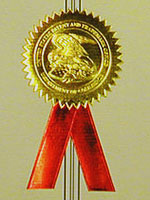Recent News
CHTM Joins NSF's NQVL Pilot Projects
August 9, 2024
OSE PHD, Dr. Xuefeng Li - Wins The Outstanding Interdisciplinary Graduate Programs Award
May 10, 2024
Dr. Ali Rastegari - 2024 OSE Best Dissertation Award Winner
May 10, 2024
2024 OSE Spring and Summer Graduates
May 10, 2024
News Archives
Patent issued to CHTM faculty members Sang Eon Han and Sang M. Han
January 5, 2017 - CHTM

The Science & Technology Corporation at the University of New Mexico (STC.UNM or STC), announces that a new patent has been issued to faculty members with the UNM Center for High Technology Materials (CHTM).
As the technology transfer and economic development organization for the University of New Mexico (UNM), STC.UNM protects and commercializes technologies developed at UNM by filing patents and copyrights and transferring the technologies to the marketplace. STC.UNM also connects companies, entrepreneurs and investors to these UNM technologies for licensing opportunities and the creation of startup companies.
U.S. Patent No. 9,530,906, “Methods to Introduce Sub-Micrometer, Symmetry-Breaking Surface Corrugation to Silicon Substrates to Increase Light Trapping," has been issued to Han et al by the U.S. Patent & Trademark Office (USPTO). The inventors include CHTM faculty members Sang Eon Han and Sang M. Han.
Abstract: Provided is a method for fabricating a nanopatterned surface. The method includes forming a mask on a substrate, patterning the susbtrate to include a plurality of symmetry-breaking surface corrugations, and removing the mask. The mask includes a pattern defined by mask material portions that cover first surface portions of the susbtrate and a plurality of mask space portions that expose second surface portions of the substrate, wherein the plurality of mask space portions are arranged in a lattice arrangement having a row and column, and teh row is not oriented parallel to a direction of the substrate. The patterning the substrate includes anisotropically removing portions of the substrate exposed by the plurality of spaces.

Sang Eon Han
Dr. Sang Eon Han is an Assistant Professor in the Department of Chemical & Biological Engineering at UNM. He earned his Ph.D. in Chemical Engineering from the University of Minnesota and his M.S. & B.S. in Chemical Engineering from Seoul National University. He was a Postdoctoral Associate in the Department of Mechanical Engineering at the Massachusetts Institute of Technology (MIT).
Dr. Han is a recipient of the National Science Foundation (NSF) Career Award in 2016; the UNM Science and Technology Corporation Innovation Award in 2016; the Ralph E. Powe Junior Faculty Enhancement Award in 2013; and a Fellowship from the Samsung Lee Kun Hee Scholarship Foundation for 2003-2007.
His current research is focused on optical and optoelectronic nanomaterials for efficient energy usage. Topics of interest include light trapping in solar cells using nanophotonics, thermal radiation, solar energy harvesting and conversion, and nanoscale thermal energy conversion.

Sang M. Han
Dr. Sang M. Han is a Professor in the Departments of Chemical & Nuclear Engineering and Electrical & Computer Engineering at UNM. He earned his Ph.D. in Chemical Engineering from the University of California at Santa Barbara and his B.S. in Chemical Engineering with Honors from the University of California at Berkeley.
Han is a recipient of the Air Force Summer Faculty Fellowship in 2012 and 2014; the UNM Science and Technology Corporation Creative Award consecutively from 2009 to 2014; UNM School of Engineering Senior Teaching Excellence Award in 2012; UNM Junior Faculty Research Excellence Award in 2005; and the National Science Foundation (NSF) Career Award in 2001. Han holds 10 UNM-affiliated, issued U.S. patents. He has over 50 publications in peer-reviewed journals and over 150 invited/contributed papers at academic institutions and conferences.
His current research topics include (1) selective growth of Ge quantum structures and high-quality heteroepitaxial films on Si; (2) III-V integration on engineered Ge-on-Si virtual substrates for photovoltaic, electronic, and sensor; (3) hybrid micro/nanofluidic systems for advanced bioseparation and analysis; (4) synthetic modification of semiconductor surfaces; and (5) nanocrystal synthesis and surface functionalization for nonlinear optical and biological applications.
Source:
U.S. Patent No. 9,530,906


